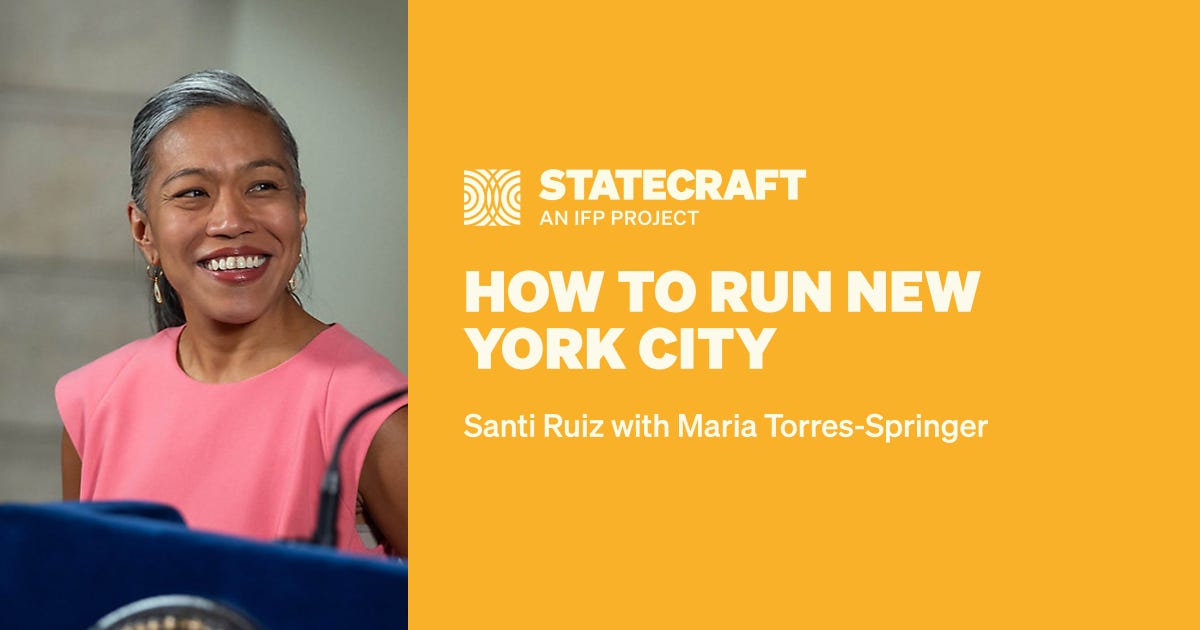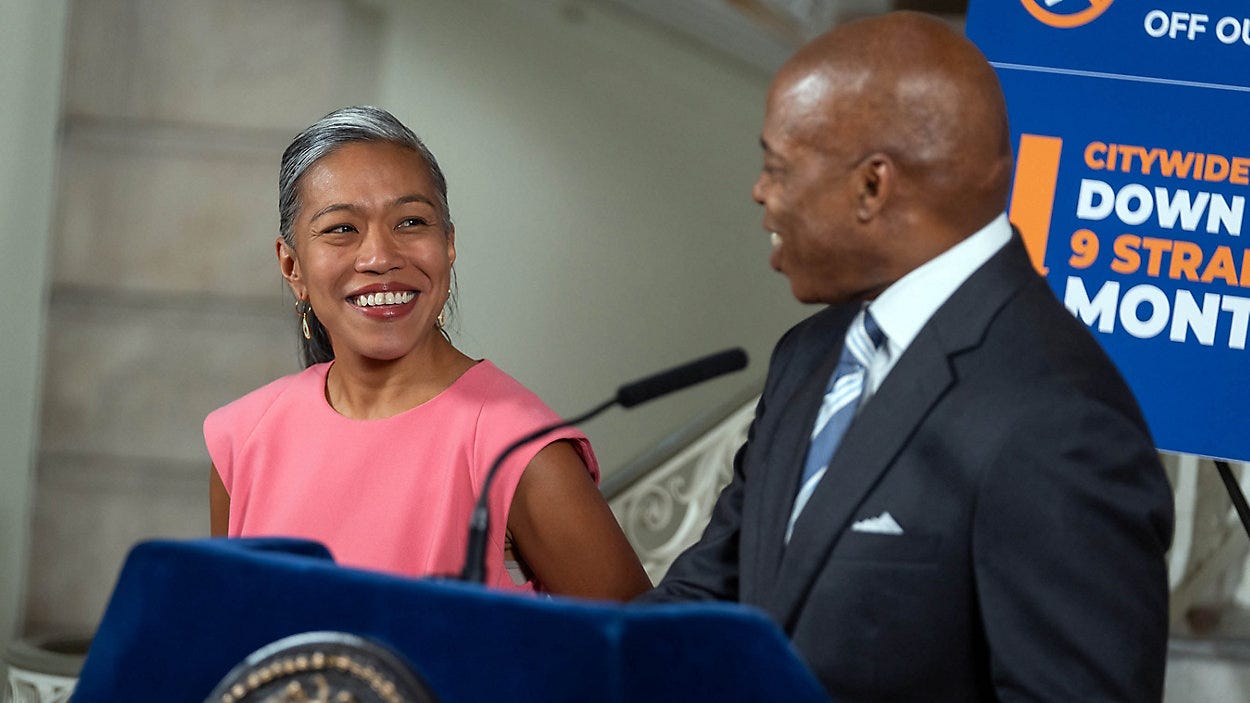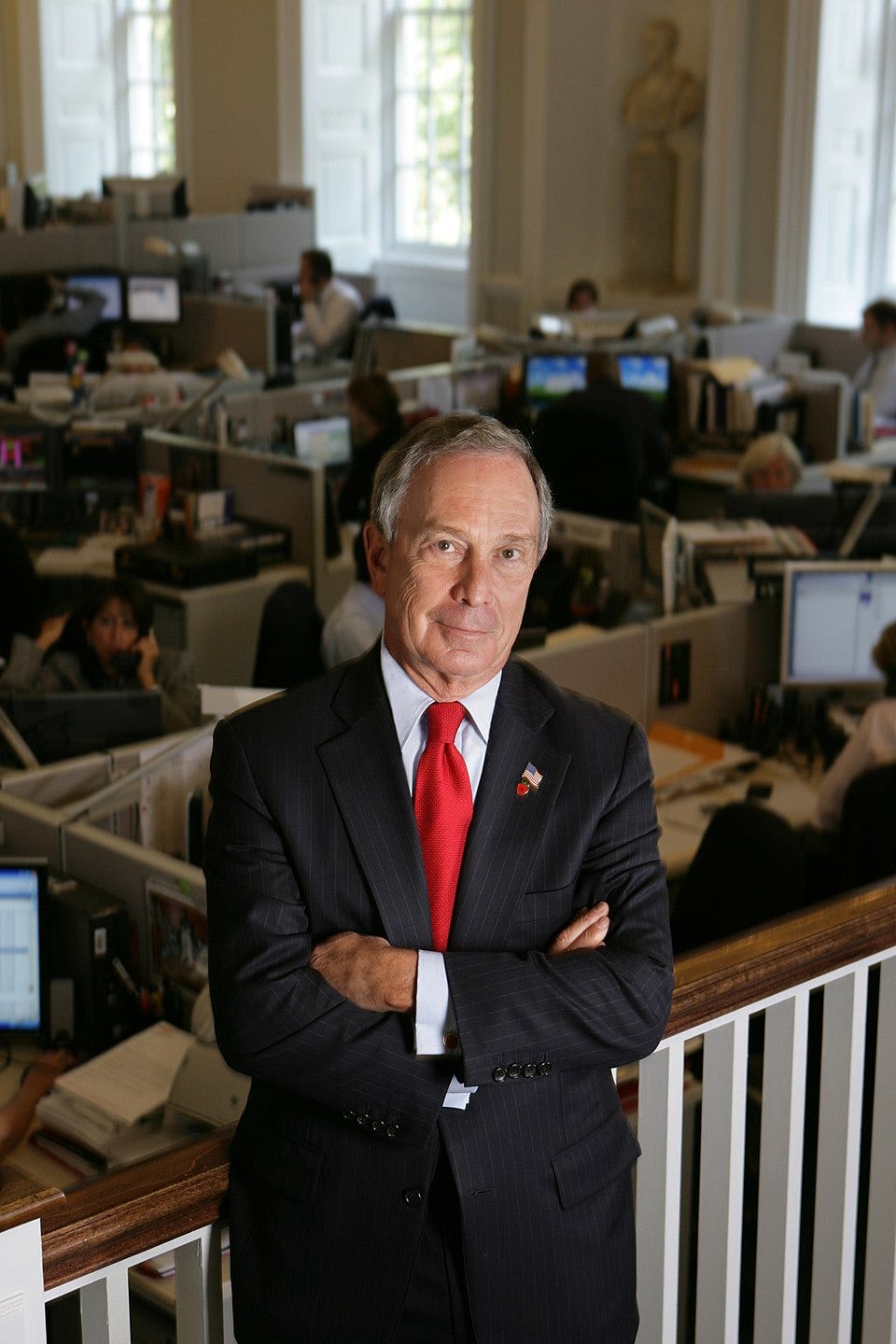The likely next mayor of New York City is Zohran Mamdani, if polling is anywhere close to being correct. I’ve been on a New York City kick recently on Statecraft (I live here), and have followed the race closely. Much of the conversation has revolved around the day-to-day administration of City Hall. If Mamdani wins, does he have what it takes to run the city’s government?
Today’s guest is still active in NYC political life, and it was clear I would not get an answer to that particular question.1 Instead, I took this opportunity to investigate how City Hall actually runs, and how the past three mayors have structured their administrations. But if you read between the lines, you can treat this conversation as a guide about what has worked in New York’s governance over the last 20 years, and the likely stumbling blocks for an ambitious new administration.
Maria Torres-Springer moved to New York City a week before 9/11, and spent most of the following 20 years in city government — first as a top appointee in the Bloomberg administration, then in several high-powered roles under Bill de Blasio, and eventually as second-in-command for Eric Adams. Her most recent role was as first deputy mayor: functionally the Chief Operating Officer of New York City. Torres-Springer resigned in February 2025 (she was not implicated in the overlapping Eric Adams corruption scandals).
To put it lightly, Torres-Springer has fans. In November 2024, City & State New York wrote a cover story titled, “The Vibe at City Hall is Thank God for Maria Torres-Springer.” It quotes political figures from the far left, center left, and right, calling Torres-Springer “a phenomenal leader,” “a very classy, charismatic, knowledgeable individual,” and, “a serial overachiever in a good way.” When Adams appointed her as first deputy mayor, he said, “She has the ability of landing the plane.”
Torres-Springer is widely described as one of the most effective political operators in New York City, and she’s been linked in media stories as a potential official in the next mayoral administration (although she recently took a role as President of the Revson Foundation, a NYC-based philanthropic organization). She’s maybe the best possible guest to talk about steering City Hall.
Given constraints on what Torres-Springer could discuss, I wanted to get into two big topics. One is process. What does it take to run City Hall? How have different mayors done it differently? The other is outcomes. Torres-Springer was one of the champions of City of Yes, the Adams-backed initiative to build 500,000 new housing units in the city over the next 10 years. I wanted to better understand City of Yes, what she’s most excited about, what didn’t make the cut, and how it all came together politically.
We discuss:
What it takes to succeed working for three very different mayors
How Bloomberg, de Blasio, and Adams governed differently
How to work effectively under constant pressure
The political coalitions that made City of Yes possible
Why it takes over a year to turn over a NYCHA apartment
How to fix the plumbing of government
What the next mayor should prioritize to keep New York thriving
Thanks to Harry Fletcher-Wood, Eamonn Ives, and Katerina Barton for their judicious audio and transcript edits for length and clarity.
Maria, I’m glad to have you. You’re headed back into the nonprofit sector, after working for three different New York City mayors: first Michael Bloomberg, then Bill de Blasio, and most recently for incumbent mayor Eric Adams.
Are there many people who have worked for at least three mayoralties?
It’s fairly atypical at the senior level to have worked for three consecutive mayors. But in the public-sector workforce — 300,000 strong — there are many dedicated employees who have worked across different administrations. I feel very fortunate to have been able to work — at times of both growth and crisis — in three different administrations, each trying to move the city forward.
Readers who are loosely familiar with New York City’s political history will note that those three mayors didn’t just have different policy outlooks — they’re very different characters. In New York City, the personality of the mayor is a topic of much public discussion: how they interact with different stakeholders in the city, whether they’re more public or private, etc. How did those mayoral personalities shape how they governed and how their administrations worked?
They say it’s the second-hardest job in the United States. You’re not just managing that 300,000-person workforce; you’re the CEO of a company that has 8.5 million shareholders, and they all voice very loudly how they feel about your performance. And you have a media environment where everything is under scrutiny, so it’s not for the faint of heart.
I started as a policy analyst in the Bloomberg administration and over the course of 20 years was able to work in three different agencies and at City Hall, until I was appointed first deputy mayor. The love all three mayors had for New York City, and their commitment to moving it forward, was irrefutable. But they all had different ideologies and styles of governing:
Mike Bloomberg had a very purposeful governing and management philosophy. He hired well and delegated responsibility to agency heads and deputy mayors. For young staffers, that meant you saw some very good techniques for how to manage a sprawling bureaucracy. They say that New York is ungovernable, but that administration did as much as it could to bring order to what can often be a chaotic environment.
The governing philosophy of Mayor Bill de Blasio I would describe as: he knew what his North Stars were. There were some very important initiatives and priorities — universal pre-kindergarten, his affordable housing plan. Because it was so clear what those priorities were, that allowed government to organize itself — [which] allowed for the quick and successful implementation of ambitious initiatives.
Mayor Eric Adams prioritized being accessible to everyday New Yorkers and creating a porousness to ensure that the voices of those New Yorkers who may have been betrayed by the government, or didn’t have access to it, were heard. That meant we had to be focused on constituent services and making sure that we were thinking about how government needed to work better for the greatest number of people.
Despite three different mayors, there is a workforce within city government that is incredibly focused on not just responding to shifts in the political wind, but turning vision and mayoral agendas into very practical results for New Yorkers.
You mentioned that Bloomberg came in with a history of management and ideas about personnel, hiring, and delegation. In your time as first deputy mayor, you spent time reviewing City Hall personnel, policies, and programs, and trying to figure out, “What’s the right way to manage and structure the inner workings of this massive administration?” What did you learn from Mayor Bloomberg — whether it’s broad principles or specific things about how City Hall needs to run — that you’ve tried to implement?
I learned from each of the mayors. From the Bloomberg administration, the use of data — the importance of answering, “What is the best solution to this problem?” before you start trying to triangulate and solve for politics — was a very early and useful lesson. The need to build the right teams: one of the most important assets that any senior leader has in government is the team he or she is leading. If you create an environment where team members are empowered and trusted, where they can not just execute programs but also imagine how government can do its best work, then you create these “ride-or-die” teams. I knew every day that my life depended on the strength of the teams that I was working with. Those were early lessons that I learned from Bloomberg: how to make sure you assemble, nurture, and empower the right people, with the right expertise, in the right formation, toward the right goals, at the right pace, to get done what needs to get done.
Can you get a little bit more specific? In practice, what have you done to make sure you have teams that are operationally excellent?
When you hire for particular positions, it’s important not just to ask: “Are they qualified for the job?” There are a number of people who have the right skill sets and background for a number of positions. But in government you’re also solving for a couple of other questions. For example, “Why are they interested in this business?” It can’t just be because of a desire to give back. Those who I’ve seen step up over time and be resilient are those who have a sense of personal mission and of what they uniquely can accomplish in government.
Sometimes that’s because they have a particular lived experience. In my case, I grew up with housing insecurity and I knew what it felt like for government to work or not work. We grew up with a Section 8 voucher and we depended on it. That translated to a career in public service where I never forgot what was at stake. This wasn’t just about high-falutin policy, or jargon, or a bunch of policy wonks trying to find solutions. It was a matter of life or death for the people we were trying to serve.
Over the course of hiring and managing, did you find applicants who want to work in city government but don’t have that specific sense of what they can do? They’ve got a generalized sense that, “It’s a good thing to work for your city.”
I do, but that’s okay, especially for early-career professionals. You might not come in saying, “I want to fix this crisis, and here’s the long list, here’s my autobiography, and why I’m uniquely positioned.” But I would test for a sincerity in why they want to be in government and an aptitude for solving problems in government.
You get more responsibility as an early-career professional than you probably should. Those who take that responsibility seriously say, “I’m not going to squander this opportunity. I’m going to be the type of professional who is curious and will stop at nothing to find the right set of solutions.” Importantly — and this is prized in most work environments, but in particular in government — [we need] someone who works well in teams and is able to collaborate across different agencies, inside and outside of government, under extraordinary time constraints, and where a lot is on the line.
I’ve got here a picture of the open floor plan that Mayor Bloomberg had in his office, which I understand was novel at the time. Was he right to get rid of the big-box cubicle model and put everybody in the bullpen together?
It was the first bullpen I ever knew. If it’s any indicator, that setup still exists — persisting through the de Blasio and Adams administrations. Some of the conference rooms in the last two administrations were converted back into offices, but most of the City Hall staff still sit in the bullpen.
It was novel at the time, maybe even radical, but it had benefits. Some are probably pretty obvious. New York City government is at a scale and pace that is unimaginable. On any given day, there are 12,000 tons of trash that have to get picked up, one billion gallons of water that need to be supplied, 30,000 acres of parkland to be maintained. Anything that you can do, office format included, to create a better velocity of communication and action is helpful.
The other thing is transparency. You knew where everyone was. You could overhear who was having an argument and how issues were getting resolved — from the first deputy mayor to a policy analyst who just started the week before. In fact, when I was appointed as first deputy mayor, one of the things that I did was to create a rotating desk up in the bullpen, do various deputy mayors would spend time upstairs. This wasn’t just symbolic; it was a way to show that we prioritize accountability and transparency. You create an environment that prizes execution and low drama versus palace intrigue. That’s the type of culture that every mayor should strive to create.
I’m wondering for you and for the mayors that you’ve worked for in this environment in which everything happens incredibly fast — and at least in the 21st century, it’s been very much an open office, info-sharing environment — when do you get time to sit and think? When does the deep work or the processing happen?
That’s a good question. Probably those moments didn’t happen often enough or at the length that is necessary to do that type of deep processing, but I was very intentional about creating spaces for that. There’s a crush and heave to the work, and it’s very easy for you to let the work happen to you. There’s a crisis every day, there’s a press story every minute, and meanwhile the deadlines continue.
When I was appointed in the Adams administration as deputy mayor I brought back a practice that I saw in the Bloomberg and de Blasio administrations. I brought together all of the agency heads within my portfolio for a monthly lunch. That might sound very basic, but it was a rare opportunity for leaders to come together, and share not just the critical priorities of the month, but to hear from other leaders, tackle problems together, and syndicate their strategic plans. You have to be very intentional, especially at the beginning of an administration, because you are trying to do three things all at once — running a government, changing a government, and building a government.
It was important to me to have a process in the beginning of agenda-setting. We have blueprints on housing, economic development, workforce development, and climate, that were established early on. This was an exercise, not just in creating glossy brochures that no one read, but in ensuring that we set some markers about what needed to happen with a particular policy domain or agency in order to not mistake activity in government — which is always quite feverish — for direction.
What kinds of benchmarks did you set for yourselves?
A major one in housing, for instance, was a moonshot goal of 500,000 units of new homes over the next decade, backed up with very detailed plans about how we were going to get there. For economic development, it was not just regaining the one million jobs we lost during the pandemic, but also topping the total employment and private-sector employment records the city held before the pandemic. On workforce development, we had a goal of 30,000 apprenticeships, which was a new model for workforce training in New York.
Each of these blueprints had a major overall goal and a number of intermediate key performance indicators that we wanted to track, in order to ensure we were making good progress, because the goals were meant to be moonshots. They weren’t foolishly derived, but they were ambitious enough to galvanize and inspire public servants and partners outside of government to do more and better for New Yorkers.
In the transition from Mayor Bloomberg to the next mayor you worked for, de Blasio, what changed about how City Hall was managed?
After three terms in the Bloomberg administration, we had new leaders, new energy, and new plans. The styles were different. For Mayor de Blasio, in order to make sure we had the right process for decision-making, [we used what] we called the decision memo matrix. We had to be very clear about what exactly we were trying to accomplish: what was the decision? Who had to sign off? What were the budget implications? Every mayor has his or her own way of making decisions, but in a new administration the principal has to set some guardrails for how he or she will decide on matters small, medium, and large. It was a process of getting acclimated to a new way of making decisions, a new set of priorities, and new people in these roles.
What do you think are the pros and cons of that decision memo matrix in the de Blasio administration? What did it help City Hall do better? What did it trade off against?
It establishes — just because of what you had to write down — a framework for what’s important, what needs to be addressed, and who needs to sign off before something is ready for a decision by the mayor. To the extent that there were informal ways that other administrations may have come to decisions, that type of process makes very clear the different components of a good decision.
There are a couple of drawbacks. One is that our problems are so complicated and nuanced in New York, and there’s something about putting it in a memo that almost flattens or simplifies it. It was important to supplement [the memo] with discussion in real time — with people looking at each other eye-to-eye, to contend with gnarly decisions you can’t quite summarize in a particular memo.
The other thing that every administration needs to think about is: “Does the process create structure, but also bottlenecks?” If at the end of the day you were left with 200 decision memos — that had to be read, vetted, and resolved — but it slows down the process, there’s room for tweaking and modification. [The new mayor has] to figure out what process they need to make the right decisions — and make sure that that process results in a quality and speed of decision-making that is commensurate with the complexity of the job.
Are there specific steps that any of the administrations took on revamping the org chart or improving efficiency that you would 100% say: “Yes, the next administration should copy-paste that particular practice”?
There are principles that I have observed and learned that if anyone asked me, “What does it mean to govern? What does it mean to structure City Hall?” I’m a broken record about.
Number one is to make sure that the system is simple and transparent. That starts with reducing bureaucratic friction by having an org chart people can understand and doesn’t have too many silos or portfolios. Not because you think your senior leaders won’t get along, but because it is just human nature that silos create competing priorities and personalities. Anything you can do to have the minimum number of direct reports to the mayor allows for the trade-offs and decision-making to happen more readily.
Number two is focusing on communication, internally and externally. The major currency in a place like City Hall is information and access to the mayor. If you make those things scarce, then that results in confusion and game-playing that you don’t want.
What kind of game-playing?
Everyone is vying to get access. Everyone is trading on information — it’s not that it’s secret, it’s just that a decision is made and it hasn’t been communicated back to the teams. So that discipline of feedback loops, of communicating big policy decisions, certainly before they’re in the press, matters. You’ll be surprised how important that is to ensure that the staff at City Hall trust their leaders and therefore act in trustworthy ways.
The third is anything you can do to minimize drama. The public servants I’ve worked with all want to focus on the very hard work of government. The less intrigue, infighting, public spats, and scandal that they have to contend with on a daily basis, the more they are focused on the work. All the ways to create a low-drama culture where you show that what is prized is quiet execution, not intrigue, will go a very long way.
How did you try to reduce the amount of drama in City Hall? What are the concrete tips there for dialing it down?
Always operate honestly and transparently. I can’t tell you how important having those North Stars was. In any administration there will be natural or manmade crises. We had this mantra in my team: “We have to walk a straight line through the initiatives that we set out — to combat the housing crisis, to bring back jobs — despite all of the distractions that will come our way.” There was clarity about what the priorities were. There will always be a day where there is stuff in the news. It’s human nature to pay attention for a second, but my team knew what their day jobs were. That type of clarity — those types of playbooks of what needed to get done — was important.
Most important is doing everything that I could to model low-drama behavior. Everything within City Hall and government is contagious. You set the culture early on, and it spreads and embeds. As senior leaders, if you want a no-nonsense, low-drama — “This is a place of employment, we are here to make sure that tax dollars are spent wisely” — and that’s what you model, then you have teams that do just that, even during times of crisis.
On that point about culture flowing down from leadership, I’m curious about your time as commissioner of the Department of Small Business Services under Mayor de Blasio. He famously was not especially friendly with the business community. I’ve got an interview here in which he said: “Mayors should not be too cozy with the business community.” How did that attitude from the top affect how you ran the department?
…Here’s what I’ll say. There are the words that people use and then there’s the business of government. The private sector is obviously not monolithic. There are major corporations which employ many New Yorkers, small businesses where a lot of job growth happens, and all the types of firms in between — architects, builders, and other professionals. Everything I did — in Small Business Services, at the Economic Development Corporation (EDC), or in housing — doesn’t happen just because of government alone. Every unit of housing that was built was built because it was a partnership between public and private. In the EDC, when we were growing industries — from life sciences to fashion — that involved private-sector partnership as well. In the Department of Small Business Services, the programs that we ran were all about: “What does it mean to help our mom-and-pop businesses and higher-growth companies hire more people, and have a better experience dealing with government?” For too many of them, it was Kafkaesque.
What I relied on in each of these roles under the three mayors was thinking, “How do you use the superpowers of that agency to help New Yorkers who are running a business or employed by a small business?” That kept me and the teams focused on the mission, versus the back-and-forth in the media more generically about the business community.
Let me ask you about another initiative under Mayor Adams on which you spent a huge amount of effort: City of Yes. I’m probably oversimplifying by calling it a major rezoning effort, but that’s a big part of it: opening up land in the city for housing. I’d be curious to hear what in that massive body of work you’re especially excited about, and what didn’t get into the final version that sailed through the city council on a fairly close vote. Obviously it had to get trimmed down to meet the moment politically. I’m curious what you wish, in retrospect, could have been squeezed in there that might have to be left for the next round.
I am very proud of the work that we did through City of Yes. It was three different citywide text amendments [to the zoning code]. One focused on our goals in carbon neutrality, the second on economic development, and the third — the one that garnered the most headlines and was most difficult politically — was the City of Yes for Housing Opportunity.
It is the most pro-housing set of zoning reforms the city has ever seen. It enables a little bit more housing in every neighborhood of New York, by clearing out a lot of the barnacles in our zoning code and relaxing certain requirements. There are close to 60 community districts in New York and we’ve seen more housing production in 10 of them than in all of the other 50 or so combined. So something is obviously amiss here.
The reforms you mentioned run the gamut from:
Saying, “We can add a little bit more density if you build more affordable housing.”
Legalizing Accessory Dwelling Units (ADUs): the cottages, basements, and garage conversions that we’ve seen in other places are quite helpful to boosting housing supply.
Looking at the more modest housing [developments] — transit-oriented and what we call town center — two-to-five-story apartment buildings, the mainstay of so many neighborhoods. We made it illegal to build them for a very long time, so re-legalizing those.
Relaxing parking requirements, making it easier to convert, and so much more.
In total, that’s over 80,000 new units, from our projections, over the course of 15 years.
I’m proud of the technical work, and it is significant. But what I’m most proud of is that we turned a corner in our city on imagining how we can modernize the regulatory system and do things that are politically hard. I’ve been in the housing business for close to two decades, but there was a shift, where we said, “It is not okay that there are more than 100,000 — mostly women and children — sleeping in shelters. It’s not okay that we have a historically low vacancy rate. It’s not okay that more than 50% of renters are rent-burdened.” The sobering statistics go on. But we also realized that we didn’t have to live this way. Hence City of Yes for Housing Opportunity, which cleared the city council review — the local legislative body — at the end of 2024.
You’re right that there were modifications to certain proposals, whether it’s parking or how we thought about ADUs. That was expected because this is a political process. You have to have enough humility to say, “We didn’t get every single proposal 100% right.” But there are two things that are important for moving forward. One is, as we look at the implementation of City of Yes for Housing Opportunity, to have the willingness to make amendments to where the nips and tucks were made [in zoning rules], if they are not helpful to addressing housing. Also, as significant as it was, this was only one piece of a larger strategy to confront the housing crisis. All of those initiatives — using public land more efficiently for housing, financing affordable housing production, revising our charter as we are trying to do — have to keep going with energy to make an enduring dent in the housing crisis that New Yorkers have been facing for too long.
I do want to push you on the zoning components of City of Yes. What you guys originally proposed was slightly more ambitious than what was eventually passed, because that’s politics. But are there things that you think, “If we could get another bite of that apple, we want to push for — this or that zoning reform — that didn’t get through the first time”?
I would pay attention to whether or not we are seeing the building of Accessory Dwelling Units as aggressively as we want. There were modifications made to where and how they can be built. I would also track how the new parking rules get implemented and where we are seeing housing being built, or not, as a way to ask ourselves the question: “Is there more that we can and should do here?”
I’d also want to make sure that we’re seeing growth, whether it’s from office conversions or transit-oriented development more generally. On transit-oriented development, as improvements are made to our mass transit system, we will see building coming out of City of Yes. But there are other opportunities outside of City of Yes to better map where transit improvements are happening and think about what that means for rezonings. The goal is always to ensure that growth is happening where there is proximity to jobs and transit that can accommodate that growth. So I’m very excited, for instance, to see where the aspirations for building more that we announced in the Manhattan Plan will lead us.
I’m curious about the politics of City of Yes. City council members have their own local constituencies, and often t’s easier to advocate for more housing at higher levels than at local levels. The State of New York has a lot of say in the regulations governing housing production here in the city. How did you think about putting together a coalition that could pass City of Yes?
City of Yes was not just a set of technical reforms, but it became a political, institutional, and in many ways even a moral project for those of us who were involved. This was a matter of who belonged in our city and whether we were going to create a city for generations to come or a city for the privileged few. If we were looking at this as not just a technical project, but a moral project, that meant we had to transcend our routine politics. It doesn’t mean that it was easy, but we did receive the support of the city council, with enough votes to ensure that it passed. They wanted to make sure that it wasn’t just zoning reform, that it was an entire package of investments, which we were prepared to do all along. So there was $5 billion committed to housing programs and infrastructure upgrades. A billion of that came from the governor. So Albany, the state legislature, and the governor were critically important.
The state legislature, some months before the City of Yes for Housing Opportunity was approved, also passed reforms to lift an artificial cap on density — that [change] made it possible to do conversions. So it’s necessarily many levels of government working together because the policy mattered.
Importantly, Santi, it was a very big tent: an exercise in coalition-building from housing advocates to developers, houses of worship to labor — very important that they were part of this — cultural institutions, the business community, and many others in between.
As I was getting ready for this interview, I talked to a New York real estate developer. One of the things he praised was that when a developer submits plans to the Department of Buildings (DOB), they can submit them through an online portal. The DOB reviews them, gets you back the notes and annotations, and that all happens on the portal. He talked about how in Los Angeles you have to roll up your plans in a big tube, and drive it over to the office. They eventually lay the plans out on the desk and annotate them by hand. Then you’ve got to go pick up your tube.
In your experience, how important are those kinds of procedural tweaks — not about zoning, but how we run that process? Is it more of a cosmetic thing?
No, it is not at all cosmetic. This is fundamental to fixing what people have called, “the plumbing of government.” Whether it’s the permitting for the building of housing, or for a restaurant to have all of its permits to start operating — too often that experience is Kafkaesque, where you have more than a dozen agencies not talking to one another, and you literally have to make your way to each one. Throughout this entire time you are losing time and money. That is not a good situation.
In the housing space, every day of delay where you can’t occupy a unit, that’s a family staying another day in a shelter. So the fixing of the plumbing, the automating of the systems, the digitizing of the processes is fundamental to fixing the process. The work I was focused on with many colleagues is to map it out from the beginning — through the entire environmental review, the land-use process we just talked about, then the permitting — and say, “How long is it taking? Where are the bottlenecks?” Have a system that works better for the constituent, the consumer — rather than a system that reflects the government org chart, which is too often what happens. We made a lot of good tech-enabled progress there, but there’s a long way to go to make sure that we are reducing the procedural bloat that exists in too much of government.
Is there one procedurally bloated process that you managed to wrangle into something more reasonable? And is there something that the next administration, whoever leads it, should look at and tackle — a bloated process that needs love?
If a small business is trying to operate in New York, it has to interface with a dozen agencies. In the previous process, you had to fill out who you were and all of the vitals of your business multiple times and a new form each time. What we have migrated to in New York is a unique identifier, so every agency in government knows who you are. It sounds simple, but the amount of time that a small business has to take just to get to the starting line was just too long.
There’s wonderful progress made, as you mentioned, with agencies like DOB. There are many other agencies who are involved and have to sign off. There’s DOB, the Housing Preservation & Development Department (HPD), the fire department and others. The work ahead is to not just improve the systems of those agencies, but to ask, “How can we build a better overall process for the user, and not just automate current processes, but get rid of steps that no longer serve a use?” That’s where you move beyond what’s cosmetic to something that truly does save time and energy.
As first deputy mayor in this most recent administration, housing was your portfolio: not just the City of Yes and zoning reforms, but managing the New York City Housing Authority (NYCHA). There’s been reporting over the last few years about the vacant units that NYCHA manages. It takes, on average, over a year to get tenants into a NYCHA apartment. A chunk of that — a few months — is because NYCHA has to renovate a huge amount of apartments. These were built a very long time ago, and the federal government has pushed NYCHA to get rid of lead and all kinds of other issues. But I’m curious: what are the other things that are making it take a year to turn over an apartment?
NYCHA is the largest public housing authority in North America: about 350 developments, more than 170,000 units, and 1 in 17 New Yorkers, which might even be an undercount. It’s a massive operation. You mentioned the vacant unit challenge, but for everything that might go wrong at NYCHA, the easiest thing to do is to say, “This is managerial incompetence.”
There are certainly examples of that. But this is a deeper, harder story about governance and investment. You mentioned some of the most important elements. It’s an aging housing stock — NYCHA developments average about 50 years old. So every unit requires the type of upgrade that deals with lead or sometimes asbestos, plus any electricals or plumbing that needs to be fixed. What might look like delay is the effort needed to make sure that a deeply-deteriorated unit is habitable.
There’s also structural underfunding. The last assessment for NYCHA totaled the capital repairs needs at about $80 billion. That is not coming in one big check from the federal government. That requires the type of financing where you braid together different revenue streams in order to rehab that unit. There are also realities in terms of the workforce, from civil service rules to union contracts, that have to be considered.
There’s also the environment that NYCHA operates under. There is a federal monitor. Everything that goes wrong is in the front of one of the tabloids. In that environment, the teams have to work with an extraordinary amount of care and discipline.
NYCHA is tasked with caring for the nation’s oldest housing with thin resources and challenges that no private landlord has to deal with at that scale. This doesn’t mean that it can’t do more and better: it should. That’s where we need to diagnose what is causing the failures in the system, and then for all levels of government to come together to fix those failures.
If you were going to give a laundry list to the next administration of the things in your control to make sure more people are moving into those houses — since, as you pointed out, every day a family is waiting to move in is a huge cost — what is in the next administration’s control? What could it do to refocus the city on getting that number down?
You have to identify the specific problems. You can have big goals, but you also need to think about those issues that affect individual people and families, and make no sense at all to the average New Yorker. It probably is infuriating and confounding that there are vacant units anywhere in New York given our housing crisis. Say you want to fix them, make a list, and they may not be the only problems to fix within an agency, but you’re clear about what you’re going to measure and focus on. Then get to fixing the underlying issues that are causing that problem.
So go about it methodically:
What’s the funding situation?
What is needed in order to make the investment? Because it can’t all come from government.
Do you have the right models that involve different parties, including the private sector, to stretch the public dollar?
Are you thinking as carefully and strategically as you need to about work and civil service rules? That’s the environment — it’s not going to go away. You have to understand where you can make changes that are feasible and will be impactful: where the juice will be worth the squeeze.
Finally, how do you hold yourself accountable? How do you set a goal for the clearing of those units? Be clear about what your goal is, and tell New Yorkers how you did in that year towards that goal.
I want to ask you about an equivalent issue in the private sector. There was a program called Unlocking Doors, which pledged up to $25,000, and later up to $50,000, for landlords if they would renovate low-cost apartments and get them back on the market. Only one landlord applied in the first iteration of that program and didn’t end up following through. A property manager was quoted in the Gothamist saying he’d rather take money from the mob, because the process to get reimbursed from the city was so onerous you couldn’t rely on it. There were other complaints as well.
I know, going way back in New York’s history to the ‘80s and ‘90s and these cash-crunch times, one of the things that the city had to do was slow-walk paying contractors. During that financial crisis this was a huge gripe — that you couldn’t trust New York to pay you. How do you manage paying contracts? Because there’s a perception, at least in some corners, that you don’t want to be waiting to be paid by the City of New York.
That’s an interesting program that you mentioned. It had very laudable goals: with some funding, you could unlock units that otherwise were laying vacant in the private market. Uptake, from what I understand, has not been particularly strong. That’s a perfect example of, “This program has not met its original aspirations. Is it because it’s taken too long to make the payments once someone is signed up? Or is it that there’s something more basic about its terms that is just not as attractive?” Because if the economics don’t work, then owners certainly are not going to go through the paperwork pain of waiting for those payments to come through. That’s the analysis that needs to be done so that the program gets modified.
Here’s where it becomes hard for the work of public servants. When someone takes a risk on a program, one that hasn’t happened before, some of those programs are not going to be successful. That’s inherent in trying to solve novel problems with novel solutions. Too often when something doesn’t work, it’s called a failure. The tone is too accusatory — and public servants won’t take the next risk. That’s a shame, because if it’s only programs where all the dies have been cast that we know will absolutely work, you are not incentivizing the type of innovation that’s needed in government.
I should clarify for readers: the practical reason people said they were not entering that program was what you described: the terms did not make sense financially or economically. It is not the case that people went through and didn’t get paid. That was a worry that came up in reporting. I do want to hear your point on payments.
The system to pay our contractors and vendors is a product of rules and regulations to safeguard against waste and fraud. There are good reasons why we create these systems. But over time, what that means is that it takes too long and the steps one has to go through in order to get paid are hard for any organization. It’s certainly very hard for a not-for-profit and a small business. That’s where the plumbing needs to get fixed.
There has been good work in government to better automate those systems; to ask whether we need all the approvals that are currently embedded in the process. Is there a way where we can think about reordering some of the steps to make it more conducive? We should remind your readers, this isn’t just the mayor’s office. The process of paying requires many different organizations outside of the mayoralty. All of that has to get broken down and rewired. Probably the least glamorous work in government is to fix procurement. But it’s so critical because how we run government is through partners who depend on that payment to keep going and keep delivering what we ask them to.
I want to look ahead and ask you — agnostic of whoever wins the mayoral election — what do you see on the horizon for New York. I’ll flag a couple of things that I’m especially interested in and ask you to respond. New York City’s under-five population is almost 20% smaller than it was at the very beginning of the pandemic. In 2024 there was some great population growth and good signs for New York on these metrics. But broadly, when you think about the big hit that New York took from COVID, what do mayors over the next decade have to prioritize to undo some of those losses?
It starts with the belief that, as mayor, your job is not to just manage decline. That means not taking for granted what makes New York City so amazing. We’ve been the global hub of commerce and culture. That doesn’t mean it will always be that way. We’ve been the type of place that welcomes people from all over the world, and because there’s an opportunity — I mean, I came here as soon as I could. I didn’t grow up here. I didn’t know anyone.
You and me both. I also came here as soon as I could.
I’m curious for your thoughts on the future job market in New York City. Only about 5,000 jobs have been created in the city this year to date, which is the lowest number since 1995. Since 2020, healthcare has added a huge amount of jobs — 250,000. Many of those are home health aides through programs that the city and the state support. Those in some ways are dependent on Medicaid — there may or may not be cuts there. What should the next couple of mayors prioritize if they want to see New York boom as a jobs market and continue to be the center of professional opportunity that it has been?
Over the last two decades, I was in government at critical moments where the prognosis was, “New York is dead, the jobs are leaving. This is finally it.” After 9/11, after the Great Recession, and during the pandemic. In each of those moments, New York stepped up and proved the critics wrong. That didn’t happen by accident. It’s because we have an extraordinary constellation of public and private actors who are invested in this city and want to make sure that it continues to thrive.
So what should the next set of mayors focus on to keep this standing strong? On one hand you have to be agnostic of sectors. What I mean by that is, government’s not always that great at saying, “This is the next booming sector.” That’s not its superpower. But what it can do, needs to do, and has done, is make sure that the foundations for investment and job growth continue to be strong. That is public safety, quality of life, and increasingly it’s infrastructure, transit, and housing — because businesses make decisions based on where talent is.
Nevertheless, and despite what I said about not picking sectors, it’s also important to continue to diversify the city’s economy. After the Great Recession, what that meant was a focus on tech and entrepreneurship. We’re seeing some green shoots in life sciences or in AI. So those are emerging sectors that can be nourished, because they are the engines of job growth.
The responsibility and opportunity in government isn’t just to make sure that the job numbers are up or certain sectors are strong. It’s to ensure that more New Yorkers have access to those particular jobs. That’s where the public workforce system is critical, so that growth happens in ways where the benefits accrue to as many New Yorkers as possible.
What would you recommend for folks like me, or for people who are reading this and want to better understand either how New York City works or how governance works in general?
That’s a good question. You mean aside from the Mayor’s Management Report?
Surely everyone listening to this has read the Mayor’s Management Report already.
You’ll disseminate a quiz to your readers.
I’ve found that you can triangulate the truth with a few different sources, starting with what comes from government because it has to tell its own story. That might be wonky material from agencies, or even the Mayor’s Management Report — there’s a ton of content and information. I see more and more publications like Vital City, for example, that are trying to tell the story of governing, versus other publications that, unfortunately, it’s just the news of the day or where the conflict is.
For example, New Yorkers have a decision to make this fall about how to vote on changes to our city’s charter. There are important questions that will be on everyone’s ballot about proposals that would streamline the process for building housing. It is important for New Yorkers to get educated about what is at stake in those ballot initiatives, which they can do by looking at the Charter Revision Commission website, by reading up in other publications, and by being in conversation with their neighbors, and with those who were involved with the Charter Revision Commission. That will be well worth their time, because everyone has a role to play to help address the housing crisis.
A note about gentle interviews: In both this interview and in our conversation last week with OSTP Director Michael Kratsios, there were topics we were not able to get into. Both Torres-Springer and Kratsios are live players, and in each case, I don’t think I would have received access to conduct the interviews without setting certain topics aside. That’s not usually the case with these interviews. Usually, the guests I have on are people who I think can and will speak freely; occasionally, I get the chance to interview people who I believe will be interesting despite being guarded. My goal is always to provide as much value to readers and listeners as possible within the constraints I’m working in. It’s a balance I’m still working on, and your feedback is welcome.















